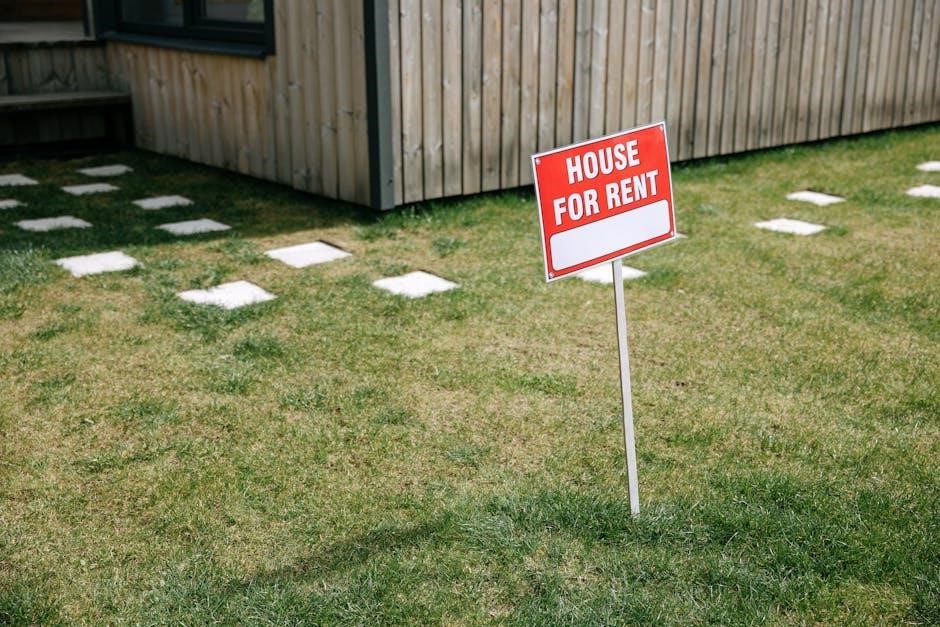The California Association of Realtors (C.A.R.) Residential Lease Agreement is a standardized contract outlining terms between landlords and tenants. It ensures clarity‚ legal compliance‚ and fairness for both parties‚ providing a customizable framework for rental agreements in California.
1.1 Definition and Purpose of the C.A.R. Residential Lease Agreement
The C.A.R. Residential Lease Agreement is a standardized contract created by the California Association of Realtors. It defines the terms and conditions for renting residential properties‚ ensuring clarity and mutual understanding between landlords and tenants. Its purpose is to provide a legally compliant framework that outlines responsibilities‚ rent details‚ and property use‚ protecting both parties’ interests while fostering a fair rental relationship. This document is widely used in California to establish clear expectations and prevent disputes.
1.2 Importance of Using a Standardized Lease Agreement in California
Using a standardized lease agreement in California ensures compliance with state laws‚ reducing legal risks for landlords. It provides clear terms‚ avoiding disputes and misunderstandings. The C.A.R. agreement is designed to protect both parties‚ outlining responsibilities and expectations. Tenants benefit from transparency‚ while landlords gain legal security. This standardized approach helps maintain fairness and consistency‚ making it essential for smooth rental transactions in California’s competitive housing market.

Key Components of the California Residential Lease Agreement
The California Residential Lease Agreement outlines rental terms‚ security deposits‚ tenant responsibilities‚ and landlord obligations‚ ensuring clarity and compliance with California rental laws.
2.1 Rental Terms and Conditions
The C.A.R. lease agreement clearly outlines the rental duration‚ monthly rent amount‚ payment methods‚ and due dates. It also specifies permissible uses of the property‚ pet policies‚ and guest restrictions. These terms are legally binding‚ ensuring both parties understand their obligations. The agreement may also include clauses on lease renewal‚ termination‚ and penalties for violations‚ providing a structured framework for the tenancy. This section ensures transparency and mutual understanding‚ reducing potential disputes.
2.2 Security Deposit and Rent Payment Details
The C.A.R. lease agreement specifies the security deposit amount‚ which cannot exceed two months’ rent for unfurnished properties or three months’ rent for furnished ones. It outlines acceptable payment methods‚ such as checks or electronic transfers‚ and the deadline for rent payments. Late fees and penalties for bounced checks are also detailed. The agreement ensures compliance with California laws‚ such as requiring landlords to itemize deductions from the security deposit. This section provides clear financial expectations for both parties‚ minimizing potential disputes.
2.3 Tenant Responsibilities and Obligations
Tenants are required to maintain the property in good condition‚ promptly reporting any needed repairs. They must pay rent on time‚ adhere to all lease terms‚ and refrain from illegal activities. Tenants are also responsible for maintaining proper trash disposal and ensuring compliance with local ordinances. Additionally‚ tenants must not sublease the property without the landlord’s written consent and are obligated to notify the landlord of any intended absence exceeding a specified period. These responsibilities ensure the property is preserved and the lease terms are upheld. Proper compliance protects both parties’ interests.
2.4 Landlord Rights and Responsibilities
Landlords have the right to collect rent‚ enforce lease terms‚ and inspect the property with proper notice. They must maintain the property’s habitability‚ addressing necessary repairs promptly. Landlords are responsible for providing a written lease agreement‚ ensuring compliance with California laws‚ and handling security deposits according to legal standards. They must also notify tenants of any changes to the lease or property management. Landlords are prohibited from unlawful eviction practices and must respect tenants’ privacy rights‚ balancing their rights with tenant protections under California law. Proper documentation and communication are essential.

Legal Compliance and California Rental Laws
The California Association of Realtors Residential Lease Agreement ensures adherence to California’s legal framework‚ protecting both landlords and tenants by meeting state-specific rental regulations and requirements.
3.1 Overview of California Rental Laws
California rental laws are comprehensive‚ governing key aspects of landlord-tenant relationships. They regulate security deposits‚ rent control under AB 1482‚ eviction protections‚ and tenant rights. The laws ensure fair housing practices‚ prohibit unlawful detainer actions without cause‚ and mandate disclosures like mold and lead-based paint notifications. Compliance with these laws is crucial for landlords to avoid legal disputes and penalties‚ ensuring a balanced and legally sound rental agreement framework statewide.
3.2 Required Disclosures in the Lease Agreement
California law mandates specific disclosures within the lease agreement to ensure transparency and tenant awareness. Landlords must disclose the identity of the property manager or owner‚ any known defects in the property‚ and the presence of hazardous materials like lead-based paint or asbestos. Additionally‚ tenants must receive information on mold‚ smoking policies‚ and security deposit details. These disclosures protect both parties by maintaining clarity and compliance with state regulations‚ fostering a trusting and legally sound rental relationship from the outset.
3.3 Prohibited Clauses in California Lease Agreements
California law prohibits certain clauses in lease agreements to protect tenant rights. These include clauses that require tenants to pay exorbitant late fees‚ waive legal protections‚ or agree to unreasonable termination terms. Landlords cannot include provisions that violate state or local ordinances‚ such as rent control laws or anti-discrimination statutes. Additionally‚ clauses that penalize tenants for requesting repairs or reporting violations are strictly forbidden. Ensuring the absence of these prohibited clauses is crucial for maintaining a legally valid and enforceable rental agreement in California.

Benefits of Using the C.A.R. Residential Lease Agreement
The C.A.R. Residential Lease Agreement streamlines the rental process‚ ensuring legal compliance‚ clarity for both landlords and tenants‚ and peace of mind through a comprehensive‚ state-specific framework.
4.1 Protection for Landlords
The C.A.R. Residential Lease Agreement provides robust protection for landlords by clearly outlining tenant responsibilities‚ rent payment terms‚ and security deposit conditions. It ensures legal compliance‚ minimizing disputes and potential liabilities. The agreement also includes provisions for handling abandoned property and terminating the lease if tenants violate terms. By using this standardized form‚ landlords can safeguard their property and financial interests while maintaining a fair and transparent relationship with tenants. This ensures a balanced and legally sound rental arrangement for all parties involved.
4.2 Clarity and Fairness for Tenants
The C.A.R; Residential Lease Agreement ensures clarity and fairness for tenants by providing a transparent outline of rental terms‚ responsibilities‚ and expectations. It includes required disclosures‚ such as information on mold and dampness‚ ensuring tenants are fully informed. The agreement adheres to California rental laws‚ protecting tenants from unfair practices and ensuring their rights are upheld. This standardized form fosters a balanced relationship‚ offering tenants peace of mind and a clear understanding of their obligations and protections under the lease.
4.3 Compliance with State Laws
The C.A.R. Residential Lease Agreement is designed to comply with California’s rental laws‚ ensuring all terms align with state regulations. It includes required disclosures‚ such as information on dampness and mold‚ and avoids prohibited clauses. This ensures landlords and tenants operate within legal boundaries‚ reducing potential disputes. The agreement reflects California’s specific rental protections‚ making it a reliable tool for creating lawful tenancies. Its structure guarantees adherence to state mandates‚ offering a legally sound framework for rental arrangements.

How to Create and Use the C.A.R. Residential Lease Agreement
The C.A.R. Residential Lease Agreement is available to real estate professionals through purchase or agreement with the California Association of Realtors. It is customizable to fit specific rental terms and ensures legal compliance‚ providing a clear framework for both landlords and tenants to establish a mutually binding contract.
5.1 Steps to Complete the Lease Agreement
To complete the C.A.R. Residential Lease Agreement‚ start by obtaining the form from the California Association of Realtors or authorized sources. Fill in the property details‚ rental terms‚ and tenant information accurately. Specify the rental amount‚ security deposit‚ and lease duration. Outline the responsibilities of both parties‚ including maintenance and repairs. Include required disclosures‚ such as mold and dampness information. Define the terms for lease termination and renewal. Review the document thoroughly before signing to ensure all details are correct and compliant with California laws.
5.2 Execution and Signing of the Agreement
Once the lease agreement is completed‚ both the landlord and tenant must review and sign it. Ensure all parties initial each page and sign the final page in the presence of witnesses if required. The agreement becomes legally binding upon signing. Maintain a copy for both parties and store the original securely. Proper execution ensures clarity and mutual understanding of the terms‚ reducing potential disputes. Adhere to California’s specific signing requirements to validate the agreement effectively.
5.3 Distribution and Storage of the Signed Agreement
After signing‚ provide a copy of the executed lease agreement to both the landlord and tenant. Ensure the original is stored securely‚ either digitally or in physical form‚ for future reference. Maintain organized records‚ including the signed agreement and any amendments. Accessibility is crucial for legal compliance and resolving disputes. Both parties should retain their copies to ensure clarity and mutual understanding of the terms outlined in the agreement. Proper storage and distribution are essential for maintaining a clear and formal rental relationship.

Common Mistakes to Avoid When Using the C.A.R. Lease Agreement
Common errors include omitting critical terms‚ non-compliance with California laws‚ and improper execution. Ensure all details are accurate and legally binding to avoid disputes and penalties.
6.1 Omission of Critical Details
Omission of critical details in the C.A.R. lease agreement can lead to disputes and legal complications. Key elements like security deposit clauses‚ rent payment terms‚ tenant responsibilities‚ and landlord rights must be explicitly stated. Failure to include abandonment terms or lease termination conditions can result in misunderstandings. Ensuring all necessary provisions are clearly outlined safeguards both parties and prevents potential conflicts. Always double-check for completeness before finalizing the agreement to avoid costly legal issues down the line.
6.2 Non-Compliance with California Laws
Non-compliance with California laws in a C.A.R. lease agreement can result in legal consequences for landlords. Failure to include required disclosures‚ such as information on mold and dampness‚ or including prohibited clauses violates state regulations. Ensuring the agreement adheres to California rental laws‚ including eviction procedures and security deposit rules‚ is essential. Using the C.A.R. form helps prevent such issues‚ as it is designed to meet legal standards. Always consult a legal expert to verify compliance and avoid potential disputes or penalties.
6.3 Improper Execution or Signing
Improper execution or signing of the C.A.R. Residential Lease Agreement can lead to legal disputes and undermine its enforceability. Missing signatures‚ lack of notarization‚ or unsigned copies for tenants can create confusion. Ensure all parties sign and date the agreement‚ with witnesses if required. Tenants should receive a fully executed copy to avoid misunderstandings. Failure to properly execute the agreement may result in legal challenges‚ particularly during eviction proceedings or disputes over terms. Always involve legal professionals to verify the signing process and maintain compliance with California laws. Proper execution is essential for protecting both landlords and tenants.
Frequently Asked Questions (FAQs) About the C.A.R. Residential Lease Agreement
This section addresses common questions about the C.A.R. Residential Lease Agreement‚ including modifications‚ tenant violations‚ lease termination‚ and compliance with California rental laws.
7.1 Can the Agreement Be Modified?
The C.A.R. Residential Lease Agreement can be modified‚ but any changes must be mutually agreed upon in writing by both the landlord and tenant. Modifications should be clear‚ specific‚ and comply with California rental laws to avoid legal disputes. Both parties must initial and date any amendments to ensure validity. It is recommended to consult a legal professional for significant changes to protect all interests involved and maintain compliance with state regulations.
7.2 What Happens if a Tenant Violates the Agreement?
If a tenant violates the C.A.R. Residential Lease Agreement‚ the landlord can take legal action‚ including issuing a notice of violation or pursuing eviction. The landlord must follow California eviction laws‚ providing proper notice and allowing the tenant an opportunity to correct the violation if possible. Failure to comply may lead to court proceedings. Both parties should seek legal advice to ensure their rights are protected and the process adheres to state regulations. Compliance with the agreement is essential to maintain a lawful tenancy. Legal professionals can assist in resolving disputes effectively.
7.3 How to Terminate the Lease Agreement
Terminating a C.A.R. Residential Lease Agreement requires adherence to California state laws. Landlords must provide tenants with a written notice‚ such as a 30-day or 60-day notice to vacate‚ depending on the lease terms. Tenants may also initiate termination by mutual agreement or if the landlord breaches the contract. Upon termination‚ the tenant must vacate the property‚ and the landlord is obligated to return the security deposit. Both parties should ensure compliance with legal procedures to avoid disputes. Consulting a legal professional is recommended to navigate the process smoothly and lawfully.
The C.A.R. Residential Lease Agreement is a vital tool for ensuring a smooth rental experience in California. By providing a standardized‚ legally compliant framework‚ it protects both landlords and tenants. Its clarity and fairness help prevent disputes‚ while its customization options accommodate unique rental situations. Adhering to California laws‚ this agreement ensures that all parties understand their rights and responsibilities. Using the C.A.R. lease agreement is a proactive step toward maintaining a harmonious and legally sound landlord-tenant relationship‚ making it an essential document for all rental transactions in the state.